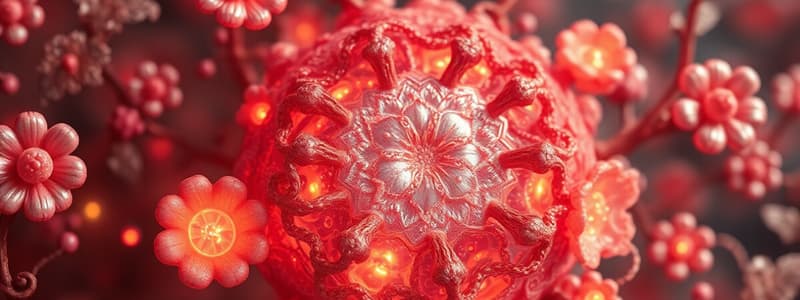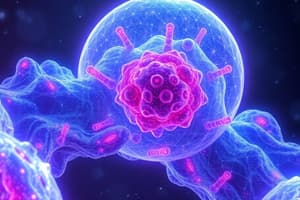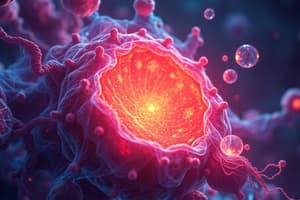Podcast
Questions and Answers
Which two domains are more closely related?
Which two domains are more closely related?
- Archaea and Eukarya (correct)
- Eubacteria and Archaea
- Eukarya and Eubacteria
- Eukarya and Fungi
What is one major step in the origin of the eukaryotic cell?
What is one major step in the origin of the eukaryotic cell?
- Replication of mitochondria
- Incubation of ribosomes
- Formation of the cell wall
- Formation of the nucleus (correct)
What are hydrogenosomes primarily associated with in organisms of the Phylum Diplomonada?
What are hydrogenosomes primarily associated with in organisms of the Phylum Diplomonada?
- Producing ATP and Hydrogen (correct)
- Photosynthesis
- Gene replication
- Cell division
Which structure is not a characteristic of the Phylum Diplomonada?
Which structure is not a characteristic of the Phylum Diplomonada?
Which feature is characteristic of the Phylum Parabasilida?
Which feature is characteristic of the Phylum Parabasilida?
What is the function of the flagella in Metamonada?
What is the function of the flagella in Metamonada?
How do Giardia reproduce?
How do Giardia reproduce?
What is a cyst in the context of Giardia?
What is a cyst in the context of Giardia?
Which fiber type in a typical Parabasilid is specifically associated with supporting the undulating membrane?
Which fiber type in a typical Parabasilid is specifically associated with supporting the undulating membrane?
What type of reproduction do Hypermastigotes primarily utilize?
What type of reproduction do Hypermastigotes primarily utilize?
In Trichomonads, which method is primarily employed for feeding?
In Trichomonads, which method is primarily employed for feeding?
Which feature is characteristic of Hypermastigotes concerning their locomotion?
Which feature is characteristic of Hypermastigotes concerning their locomotion?
Which fiber type is known to wrap around microtubules in a typical Parabasilid?
Which fiber type is known to wrap around microtubules in a typical Parabasilid?
Flashcards are hidden until you start studying
Study Notes
Three Domains of Life
- Main domains: Eubacteria, Archaea, Eukarya.
- Archaea and Eukarya share a closer evolutionary relationship.
Origin of Eukaryotic Cells
- Key steps: incorporation of organelles, gene transfer, and nucleus formation.
- Mitochondria were incorporated through endosymbiosis, providing ATP.
- Formation of the nucleus likely offered protection for genetic material and facilitated larger cell structures.
Incorporation of Plastids
- Plastids like chloroplasts incorporated through secondary and tertiary endosymbiotic events, enhancing photosynthesis capabilities.
Important Terms
- Symbiosis: relationship between different biological organisms.
- Mitochondria: organelles responsible for energy production.
- Nucleus: membrane-bound organelle housing the genetic material.
- Spliceosomes: complex responsible for RNA splicing.
- Plastid: organelle involved in photosynthesis and storage.
Phylogeny of Eukarya
- Excavata: characterized by a cavity or pocket structure.
Discoba
- Named for their disc-like plastids.
Phylum Diplomonada
- Mitochondria have been lost in this lineage.
- Contains hydrogenosomes that produce ATP and hydrogen.
- Features include: reduced mitochondria, dual karyomastigont systems, typically 8 flagella, microtubule-supported plasma membranes.
- Structure comprises microtubular roots and karyomastigont with basal bodies and nucleus.
Locomotion
- Internal flagella portions provide structural support; external portions assist in locomotion.
- Supranuclear fibers and subnuclear fibers associated with flagella.
Feeding Mechanisms
- Feeds on organic matter; phagocytosis occurs for nutrient uptake.
Reproduction
- Asexual reproduction is common.
- Giardia causes giardiasis characterized by gastrointestinal symptoms.
Phylum Parabasilida
- Six defining features: all are symbionts with a supportive plasma membrane, variable flagella count, unique fiber arrangements, reduced mitochondria, and a single nucleus.
- Two groups:
- Trichomonids (vertebrate symbionts).
- Hypermastigotes (invertebrate symbionts, found in termites and roaches).
Cytoskeleton Composition
- Pelta: wraps around microtubules.
- Parabasal Fiber: associated with microtubules and Golgi apparatus.
- Atractophore: involved in mitosis, made of microtubules.
- Axostyle: a sheet of microtubules.
- Costa: unique to Trichomonids for supporting undulating membranes.
Feeding Habits
- Trichomonads primarily consume bacteria and sometimes host cells via phagocytosis.
- Hypermastigotes feed on wood fibers and depend on symbiotic bacteria for digestion.
Locomotion Methods
- Trichomonads utilize flagella and an undulating membrane for movement.
- Hypermastigotes display coordinated movement with numerous flagella.
Reproductive Strategies
- Trichomonads reproduce via binary fission.
- Hypermastigotes can reproduce through binary fission or sexual reproduction.
Additional Terms
- Axoneme: structural component of flagella.
- Kinetosome: base structure of flagella.
- Karyomastigont system: arrangement of flagella in some protists.
- Phagocytosis: cellular process of engulfing particles.
- Cytostome: cellular mouth in certain protists.
Considerations
- Structural comparison of typical Diplomonad and Parabasilid reveals different adaptations to their environments.
- Chloroplasts with three membranes indicate a complex evolutionary history involving multiple endosymbiotic events.
- Diplomonada mitochondria largely lost functional capacity, while Parabasilida have evolved specialized structures like hydrogenosomes.
Studying That Suits You
Use AI to generate personalized quizzes and flashcards to suit your learning preferences.




